Automatic control of electromechanical double-engine traction complex of mine electric locomotives
DOI:
https://doi.org/10.15802/etr.v0i10.83521Keywords:
automation, electric, electromechanical traction system, mines, fuzzy controller, vector controlAbstract
Electric locomotive train is the main mode of transport in iron ore mines, which facilitates almost 100% of all underground freight. Electric locomotive transport uses up to 18 – 20% of total electric energy (EE) required for mine operations and is the main consumer of EE within the typical iron ore mine. A renewed initiative was sought to resolve the problem of excessive energy consumption involving the development of locally (Ukrainian) built energy efficient thermo-electric material (TEM) based IGBT – converters and asynchronous electric traction motors (electric induction motors).
Torque Vector Algorithm is the preferred method of current control within electric induction motors because of its greatly enhanced performance capabilities. However the twin induction motor traction system which operates in parallel on a common load experiences various torques and momentum forces due to a number of factors which are mechanically linked to specific axles. Equilibration of loads between the twin motors can be achieved with an aid of FUZZY controller/regulator. The controls for multiple - electric induction motor system consists of two stages – the lower stage which includes classic scheme Vector Algorithm control system, and the upper stage which includes FUZZY controller/regulator for input signals setting the rotor speed within motors (individually for each motor).
FUZZY-regulator receives mismatched input signals and representative of the actual rotor speed in induction motors and with a predetermined value of and derivatives based on the motors’ rotation speed.
The precise correction signal values and generated on the output from FUZZY-regulator are added to the last values of input signals (i.e. and ) which predetermined the rotation speed within induction motors and are also an input to the controls of the multiple electric induction motor traction system.
Induction motors were subject to full scale laboratory testing to verify the workings and efficiency of automatic control systems within multiple electric induction motor traction setup. Test results show that torque Vector Algorithm method of current control along with the input signal generating system using FUZZY-regulator shows good, promising results.
The use of a “hybrid” system of torque Vector Algorithm method of current control along with upper level FUZZY-regulator is advisable in order to improve physical performance and economic indicators related to the operations of twin induction motor traction systems.
References
Babets E.K., Shtan'ko L.A., Salganik V.A. Sbornik tekhniko-ekonomicheskikh pokazateley gornodobyvayushchikh predpriyatiy Ukrainy v 2009 – 2010 gg. Analiz mirovoy kon'yuktury rynka ZhRS 2004 – 2011 gg. [Collection of technical and economic parameters of mining enterprises in Ukraine in 2009 - 2010 years. An analysis of the global iron ore market conditions 2004 - 2011 years]. Krivoy Rog, Vidavnichiy dim Publ., 2011. 329 p.
Butt Yu.F., Gryadushchiy V.B., Debelyy V.L., Koval' A.N., Furman A.L., Shchuka V.M., Yatsenko V.A. Shakhtnyy podzemnyy transport: spravochnoe izdanie. Shakhtnyy lokomotivnyy i rel'sovyy transport [Mine underground transport: a reference book. Mine locomotive and rail transport]. Donetsk, «VIK» Publ., 2009. 481 p.
Sinchuk O.N., Chumak V.V., Erzhov O.V. Impul'snye sistemy upravleniya i zashchity na rudnichnom elektrovoznom transporte [Impulse control and protection system for mine locomotive transport]. Kiev, ADEF Publ. 278 p.
Debelyy V.L., Debelyy L.L., Mel'nikov S.A Osnovnye napravleniya razvitiya shakhtnogo lokomotivnogo transporta [The main directions of development of the mine locomotive transport]. Ugol' Ukrainy - Coal of Ukraine, no. 6, 2006, pp. 30-31.
Shokarev D.A., Skapa E.I. Asinkhronnyy tyagovyy elektrotekhnicheskiy kompleks dvukhsistemnogo rudnichnogo elektrovoza [Asynchronous traction electrical mine complex dual-system electric locomotive]. Elektromekhanichni i enerhozberihayuchi systemy - Electromechanical and saving system, issue 4 (16), 2011, pp. 45-48.
Zherebkin B.V., Shokarev D.A., Skapa E.I. Sintez struktury sistemy vektornogo upravleniya tyagovykh elektromekhanicheskikh kompleksov dvuosnykh elektrovozov [The synthesis of the structure of the vector control traction electrical systems biaxial locomotives]. Elektromekhanichni i enerhozberihayuchi systemy: shchokvartal'nyy naukovo-vyrobnychyy zhurnal - Electromechanical and saving system: quarterly scientific journal production, issue 4 (16), 2011, pp. 17-21.
Kordakov V.N., Korzhev A.A. Metodika opredeleniya ratsional'noy velichiny sily tyagi dopolnitel'nogo lineynogo elektroprivoda rudnichnogo elektrovoza [Methods of determining the value of a rational traction additional linear electric mine locomotive]. Problemy mashinovedeniya i mashinostroeniya - Problems of Mechanical Engineering, and Mechanical Engineering, issue 29, 2003, pp. 120-125.
Bertil Oberg. Computer-controller ore transformation at the LKAB mine in Kiruna. – Sweden Information of ASEA. – 1979. Р. 212.
S.Florentsev,A. Pukhovoy, I. Uss, D. Izosimov, L. Makarov. Agricultural tractor with pure electromechanical drivetrain. SAE 2011 Commercial Vehicle Engineering Congress. September 13 – 14, 2011. Rosemont. Illinois USA. Session CV707. Paper No. 2011-0-2296.
Dankmeyer Hugo. Kopalniana lokomotiwa przewodowa o podwyzsznoj zdolnosci przewozowej. – Pns. gorn. – 1979, 35, N 10. – c. 432 – 438. LIV.
S.Florentsev, D. Izosimov, S. Baida, A. Belousov, A. Sibirtsev, S. Zhuravljov. Complete traction electric equipment sets for hybris buses. APAc16. 16th Asia Pacific Automotive Engineering Conference. October 6 – 8, 2011, Chennai. India. Paper No. M2010003.
Shultz L. An inverter and induction motor traction drive underground mining’s Locomotives / Shultz L., Van Wyk D., Dunford W.S., Pzest R.B., Landy C.F. // Elek. Bahnen. – 2000. – 88. - №3. – р. 145-148.
Downloads
Published
Issue
Section
License
При направленні статті в редакцію, автор гарантує, що стаття надається для публікації уперше і раніше не була опублікована в інших виданнях повністю або частково.
Підписанням ліцензійного договору автор(и) підтверджує(ють), що має(ють) виняткове авторське право на статтю і передає(ють) невиняткові права на свою статтю видавництву журналу «Електрифікація транспорту» для публікації в черговому номері журналу. Автор(и) так само дає(ють) згоду на передачу і розміщення електронної версії своєї статті на сайтах баз даних, створюваних і поширюваних через Інтернет.
